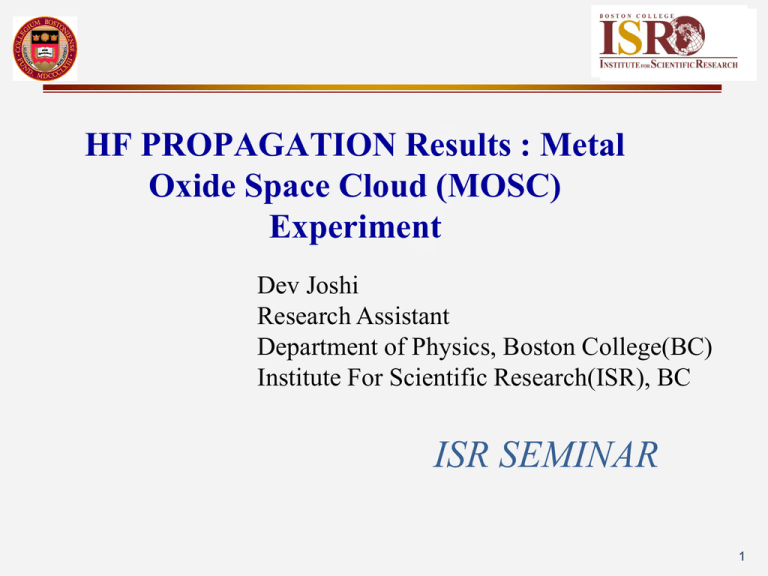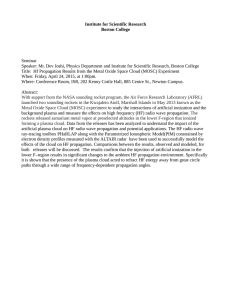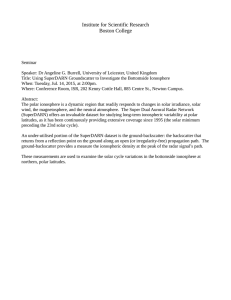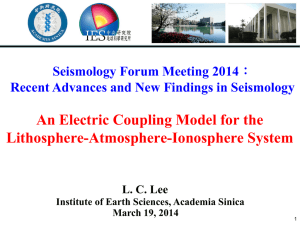HF PROPAGATION Results : Metal Oxide Space Cloud (MOSC) Experiment
advertisement

HF PROPAGATION Results : Metal Oxide Space Cloud (MOSC) Experiment Dev Joshi Research Assistant Department of Physics, Boston College(BC) Institute For Scientific Research(ISR), BC ISR SEMINAR 1 Ionospheric Modification Experiments Ionosphere Rocket Metal Vapor Release HF Tx ALTAIR Incoherent Scatter RADAR HF Rx Two types of Ionospheric modification experiments : • Ionization Depletion • Ionization Enhancement 2 HF PROPAGATION Results : Metal Oxide Space Cloud Experiment Outline : • Introduction • Ionosphere Modification Experiment • HF propagation in ionosphere • Observations • Modeling Results • Conclusions 3 Ionospheric Modification Experiments Ionospheric Modification Experiments: Various materials have been injected into the high atmosphere creating perturbations to the ambient medium. • To detect plasma drift velocities and electric fields. • To create artificial comets. • To exploit the ionosphere and magnetosphere as a plasma laboratory without walls. • To increase or decrease the plasma density in the ionosphere to trigger large scale phenomenon. • Payload for each rocket included ‒ Two canisters of samarium (5 kg yield) ‒ Dual Frequency RF Beacon (NRL CERTO) • Ground diagnostics from 5 sites included: ‒ Incoherent Scatter Radar ,GPS/VHF Scintillation Rxs, All-Sky Cameras, Optical Spectrograph, Ionosondes, Beacon Rx, HF Tx/RX 4 Ionization Depletion and Enhancement Ionization Depletion Chemistry • H2O, H2, SF6 • An example with water and hydrogen molecules These panels show pre-event conditions (a) and the resultant perturbations at 14 minutes (b), 40 minutes (c), and 107 minutes (d) after the Shuttle thruster firing in Space Lab 2 mission. Ionization Enhancement • Barium, Strontium, Xenon, Lithium, or Cesium: Photoionization • Lanthanides: Photoionization and Chemi- ionization An image of enhanced plasma in MOSC experiment 5 RF propagation : Appleton formula The Appleton formula: 𝑛2 = µ −𝑖χ where, 𝑋= 2= 1 − 𝑁𝑒2 , 𝑌𝐿 є0𝑚ω2 𝑋 𝑌𝑇2 1 −𝑖𝑍 − 2 1 −𝑋 −𝑖𝑍 ± 𝑌𝑇 4 4 1 −𝑋 −𝑖𝑍 2 +𝑌𝐿2 1 2 = 𝑒𝐵𝐿/𝑚ω , YT = e𝐵𝑇/mω 𝑎𝑛𝑑 𝑍 = υ/ω A magnetoplasma is birefringent and anisotropic. Reflection Condition: The positive sign : 𝑋 = 1 Two characteristic modes Possible: + Ordinary mode - Extraordinary mode And the negative sign gives 𝑋 = 1 − 𝑌, 𝑋 = 1 + 𝑌 Ordinary Wave Extra-ordinary Wave 6 RF propagation : Appleton formula When collisions are negligible : 𝑛2 = µ2 = 1 − 2𝑋(1 − 𝑋) 2(1 − 𝑋) − 𝑌𝑇2 ± 𝑌𝑇2 + 4 1 − 𝑋 2𝑌𝐿2 1 2 When the magnetic field is negligible : 𝑋 𝑛2 = µ − 𝑖 χ 2 = 1 − 1 − 𝑖𝑍 When both collisions and magnetic field effects are negligible : 𝑛2 = µ2 = 1 − X = 1 − 𝑓𝑁 = 9 𝑁 𝜔 = 2π𝑝 = 𝑓𝑁 2 𝑓 ; 𝑓𝑁 = plasma frequency α′ ; N is in electrons per cubic meter Higher Electron Density Lower Refractive Index Lower Electron Density Higher Refractive Index 2 𝑛𝑜𝑒 ϵ0𝑚 • Cold Plasma • No collisions • No magnetic field α′ > α α Refraction of radio waves by the ionosphere due to the changes in 7 the electron density Determination of Electron Densities A’ T = Transmitter R = Receiver Real Path Virtual Path A B B’ Ionosphere Vertical T’ R’ Oblique Earth C T Virtual Height : ℎ′ =𝑐 ℎ𝑟 𝑑ℎ 0 𝑢 = ℎ𝑟 𝜇′𝑑ℎ 0 R 8 Determination of Electron Densities Ionosonde Measures electron density profile up to the peak density height only (f ≤ fpeak) Incoherent Scatter Radar Measures direct scatter from electrons providing full height density profile (f >> fpeak) 9 ALTAIR Radar Advanced Research Project Agency (ARPA) Long-range Tracking and Identification Radar (ALTAIR) • Dual Frequency: 150 MHz/422 MHz • Max Bandwidth: 7 MHz/18 MHz • 46 m dish • Peak Power VHF: 6.0 MW UHF: 6.4 MW • Incoherent Scatter: Direct scatter from electrons in the ionosphere (10-4 m2; equivalent to a ~dime!) 10 Transmitter/Receiver Geometry N E Rongelap MOSC Release Location & Likiep-Wotho Mid-Point Wotho Likiep ALTAIR • Rongelap-Wotho link geometry is predominantly N-S and great-circle path is far from release region • Likiep-Wotho path is nearly E-W and release point lies nearly on mid-point of the link—should be ideal for observing SmO+ layer 11 Kwajalein Atoll 12 Roi Namur 13 THE RELEASE : MOVIE 14 CLOUD 15 Two Releases : 01 May and 09 May 2013 • Ionosphere during first release was disturbed, rising rapidly and Spread F formed within minutes after release • Ionosphere during second release is canonical quiescent 16 Mission 41102 Pre-Release Sweep 09 May 2013 Wotho Receiver Likiep TX Rongelap TX F –region second hop F -region Ground Wave • Sweeps from 2-30 MHz were completed every five (5) minutes - Plots show data from only 2-14 MHz since no signatures were observed at higher frequencies • Slightly higher peak frequencies on Wotho Likiep path relative to Rongelap-Wotho links probably due to longer path length, lower elevation angle propagation . 17 Mission 41102 1st Post-Release Sweep Rongelap TX 09 May 2013 Wotho Receiver Likiep TX F-layer Secondary Echo MOSC layer MOSC layer • On the Wotho geometry the layer extends up to 10 MHz peak frequency • There is also a prominent secondary F region echo; the time delays will allow us to calculate the range offsets • The discrete nature of the echo suggests a localized perturbation that extends up to the Fregion peak 18 Mission 41102 09 May 2013 Post-Release Sweep Wotho Receiver 2nd Likiep TX Rongelap TX F-layer Secondary Echo F-layer Secondary Echo MOSC layer MOSC layer • The layer has now decreased to about 6 MHz peak density • The F-region perturbation extends only mid-way up the density profile • The delay is much greater on the Rongelap link geometry compared to the Wotho geometry providing valuable information on the nature of the perturbation 19 Mission 41100 3rd Post-Release Sweep 01 May 2013 Wotho Receiver Rongelap TX Likiep TX F region perturbation MOSC layer? • No clear signatures on Rongelap link • A bottomside F-region perturbation remains on the Wotho-Likiep link, as well as a possible MOSC layer signature around 4 MHz 20 Second Release: 09 May 2013 21 Ionospheric Models Goal : Model the Background Ionosphere and the Cloud Background Ionosphere : International Reference Ionosphere (IRI) • Standard model of the empirical ionospheric climatology • Developed by joint working group of Committee on Space Research (COSPAR) and International Union of Radio Science (URSI) • ‘Input variables’ : R12 , iono_layer_parms = [foF2,hmF2,foF1,hmF1,foE,hmE] Parametrized Ionospheric Model (PIM) • Global model of theoretical ionospheric climatology • Combination of four physics-based numerical ionospheric models • ‘Input Variables’: F10.7 index, SSN, Kp index Plots courtesy of William McNeil 22 IRI and ALTAIR Profiles BEFORE 30 SEC AFTER Approximately 30 seconds after release the MOSC cloud has a peak density of about 106 e-/cc, slightly less than the background ionosphere (Ne = 106 corresponds to a plasma frequency of 9 MHz). The layer is about 30 km in diameter by this time. 23 MOSC Launch 2: May 9, 2013 Modeling the Cloud Time Period for Modeling Cloud 24 MOSC Launch 2: May 9, 2013 Modeling the Cloud The averaged and symmetrized cloud profile is used to model the cloud in MATLAB with latitude/longitude increment at 0.0141degree and height increment at 1.5510 km . The central pixel corresponds to 7.4369 MHz 25 Ray Tracing Haselgrove Equations: • Fermat’s principle - δ 𝑚𝑑𝑠 = 0 , m is ray refractive index and ds the element of path length 𝑑𝑥 𝜕𝐺 𝑑𝑢 𝜕𝐺 • Variational method – ray path equations 𝑖 = , 𝑖=;𝐺 = 𝑢 μ 𝑑𝑡 𝜕𝑢𝑖 𝑑𝑡 𝜕𝑥𝑖 • Numerical Integration of ray path equations : Runge Kutta method Coleman Method : • Point to point ray tracing • Variational principle is discretized and resulting discretized equations solved PHaRLAP: • HF radio wave ray tracing toolbox developed by DSTO, Australia • 2D raytracing is an implementation of the 2-D equations developed by Coleman • 3-D engine is based upon the equations of Haselgrove 26 Ray Tracing : Example 27 3D Ray Trace Analysis Rongelap To Wotho Rongelap Wotho MOSC Release Point • • • HF signals received well off the great circle path to the receiver The artificial cloud bends the HF energy through large angles Excellent agreement between model and observations 28 3D Ray Trace Analysis Likiep To Wotho Wotho MOSC Release Point Likiep MOSC • • Likiep Great circle path to the receiver passes through the MOSC volume Multiple paths between ionosphere, cloud and receiver expected Wotho 29 Mission 41100 Pre-Release Sweep 01 May 2013 Wotho Receiver Rongelap TX Likiep TX F-region – Second hop F -region E - layer Ground Wave 30 Mission 41100 Post-Release Sweep 1st Rongelap TX 01 May 2013 Wotho Receiver Likiep TX F-layer Secondary Echo MOSC layer MOSC layer • Note that the Likiep signature is only evident in high end of frequency range, showing up near f = 8 MHz (~07:42 UT); one might conclude this is results from the temporal evolution of the cloud, yet the Rongelap link shows the signature beginning at less than 4 MHz at least 40 seconds earlier. • One possibility is that the lower frequency components on the direct Likiep-Wotho link were actually blocked, refracted or ducted by the presence of the MOSC cloud. 31 Mission 41100 2nd Post-Release Sweep Rongelap TX MOSC layer 01 May 2013 Wotho Receiver Likiep TX MOSC layer • Peak density has decreased significantly over 5 minute time scale, primarily due to expansion of the cloud 32 Mission 41100 3rd Post-Release Sweep Rongelap TX MOSC layer 01 May 2013 Wotho Receiver Likiep TX F region perturbation • The Rongelap path shows a low density residual signature of the cloud • The Likiep path shows an emerging perturbation in the F-region • By 07:56 and beyond MOSC has disappeared and Spread F dominates 33 First Release: 01 May 2013 34 MOSC Launch 1: May 1, 2013 Modeling the Ionosphere The ‘ALTAIR’ is modelled by applying the same relative differences as in PIM in lat-lon plane at an altitude. The technique is applied at all altitudes. As is seen, modeled ‘ALTAIR’ fails to capture the shape of the high frequency tilt in PIM. 35 MOSC Launch 1: May 1, 2013 Modeling the Ionosphere The change in height of the peak density across longitudes in PIM isn’t seen in the modeled ‘ALTAIR’ ionosphere. 36 MOSC Launch 1: May 1, 2013 Modeling the Ionosphere An averaged shape function is chosen to apply to the change in the height of the peak density across longitudes. 37 MOSC Launch 1: May 1, 2013 Modeling the Ionosphere The applied shape function produced delay in good agreement except 9 MHz. 38 MOSC Launch 1: May 1, 2013 Modeling the Ionosphere • The anchor profile is taken to be the average of three ALTAIR radar profiles. • This gives delay to a good agreement with the observations. 39 MOSC Launch 1: May 1, 2013 Modeling the Ionosphere The ‘modeled’ bottomside is in good agreement while the top side is above the observations. The removal of tilt due to the shape function shows further disagreement as it raises the upside.40 Modeling : Optimization Method Optimization : Nalder Mead Down Hill Simplex Method ( Amoeba)* • Nelder, J. and R. Mead ,1965 • Direct Method : No derivatives, only function values • Idea : Move from high function (hot) areas to low function (cold) areas by reflections, expansions and contractions • “Amoeba Crawls Downhill with no assumption about function” • Built-in function in MATLAB : fminsearch *Minimization Technique suggested by Dr. Charles Carrano, ISR 41 Optimization : Model Ionosphere PIM doesn’t have enough degrees of freedom to fit the ALTAIR radar profile while optimization of foF2 and hoF2 in IRI closely matches the observed ALTAIR radar profile. Scale Vector = [ a b c …. e] 42 Optimization : Delay results The IRI model, scaled and unscaled, doesn’t match the observed delay. 43 Optimization : Delay results • Optimization of the scaling vector matches only the upside • Frequency specific optimization of the scale vector exactly reproduces the observed delay. 44 Conclusions • Ray tracing confirms sounder observations to high degree of fidelity • The change in ambient natural propagation environment due to small artificial modification can be successfully modeled • Effects from arbitrary artificial plasma environments can be predicted with accuracy • Optimization technique represents a new method of assimilating oblique ionosonde data to generate the background ionosphere (numerous applications for HF systems) • Future Work : Modeling of natural disturbances in the low latitude propagation environment to understand the effects of Traveling Ionospheric Disturbances (TIDs) and Spread F on perpendicular and quasi-parallel (to B) paths. 46 Thank You. 47






